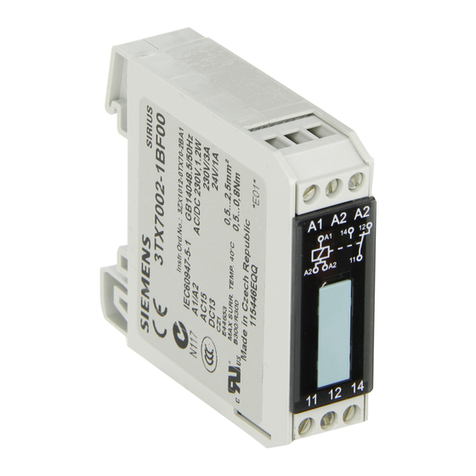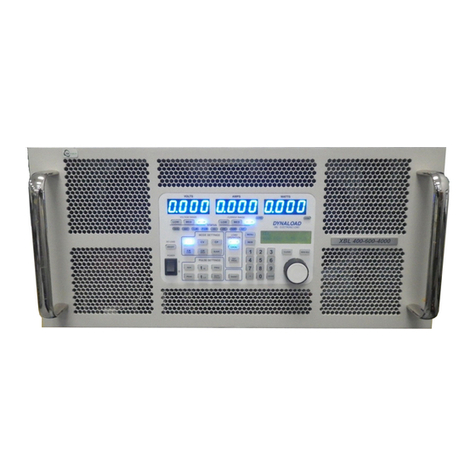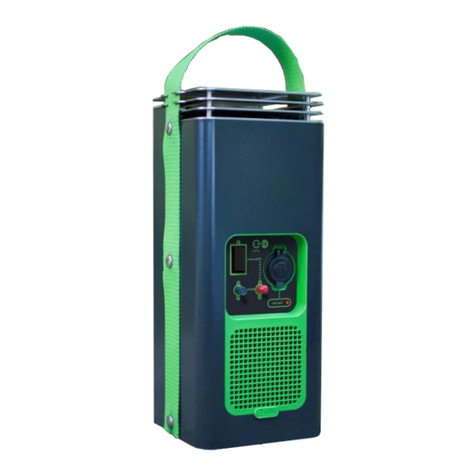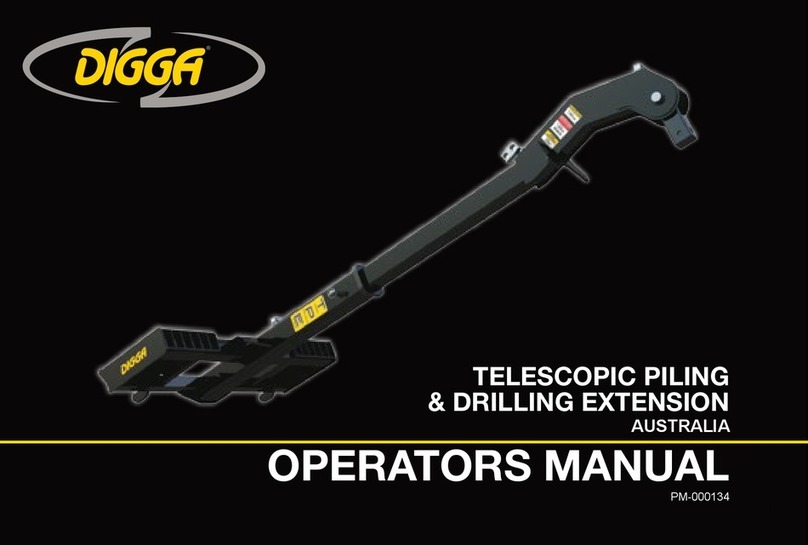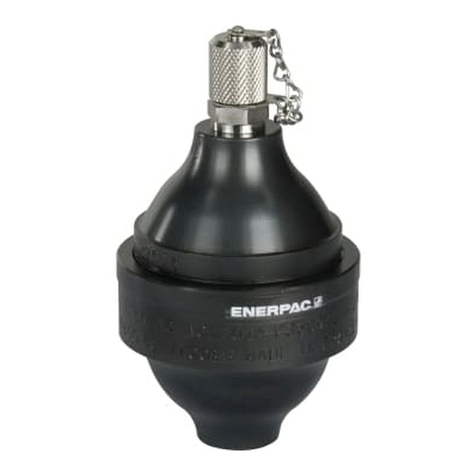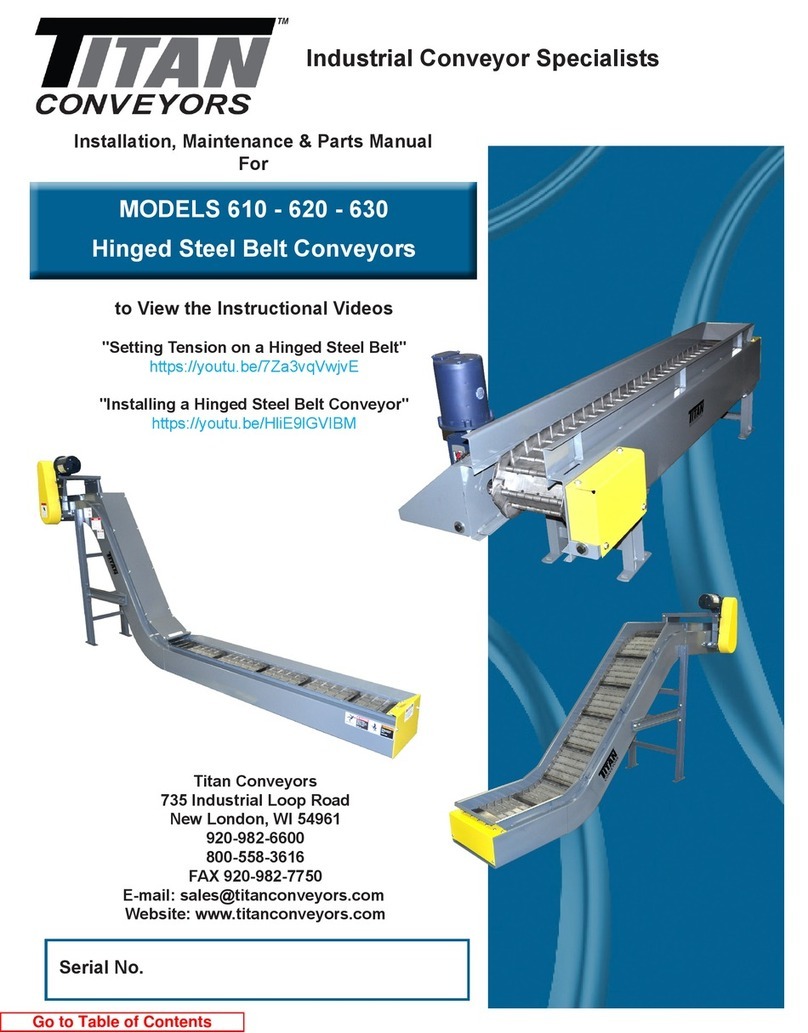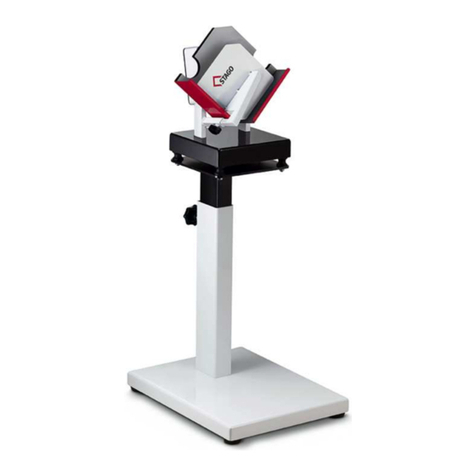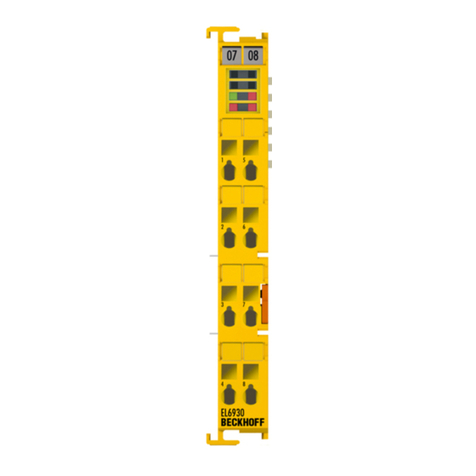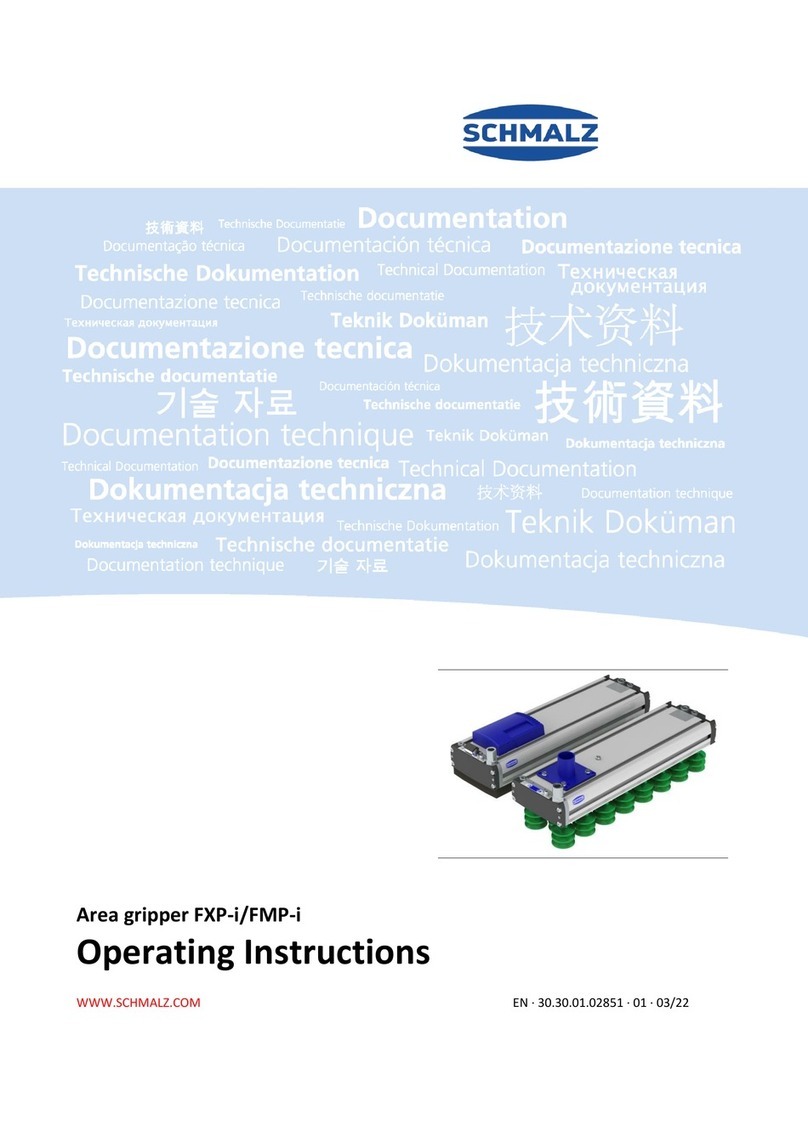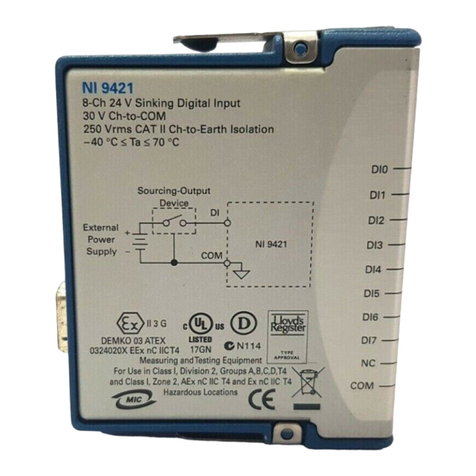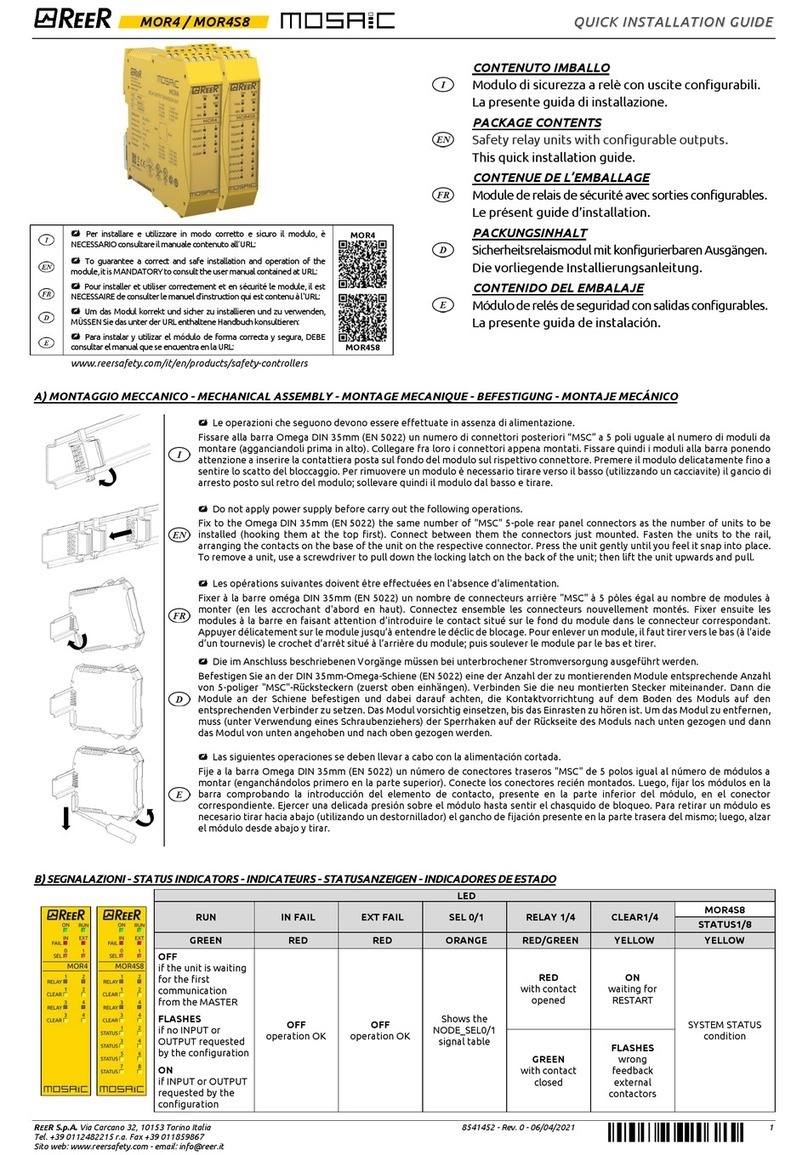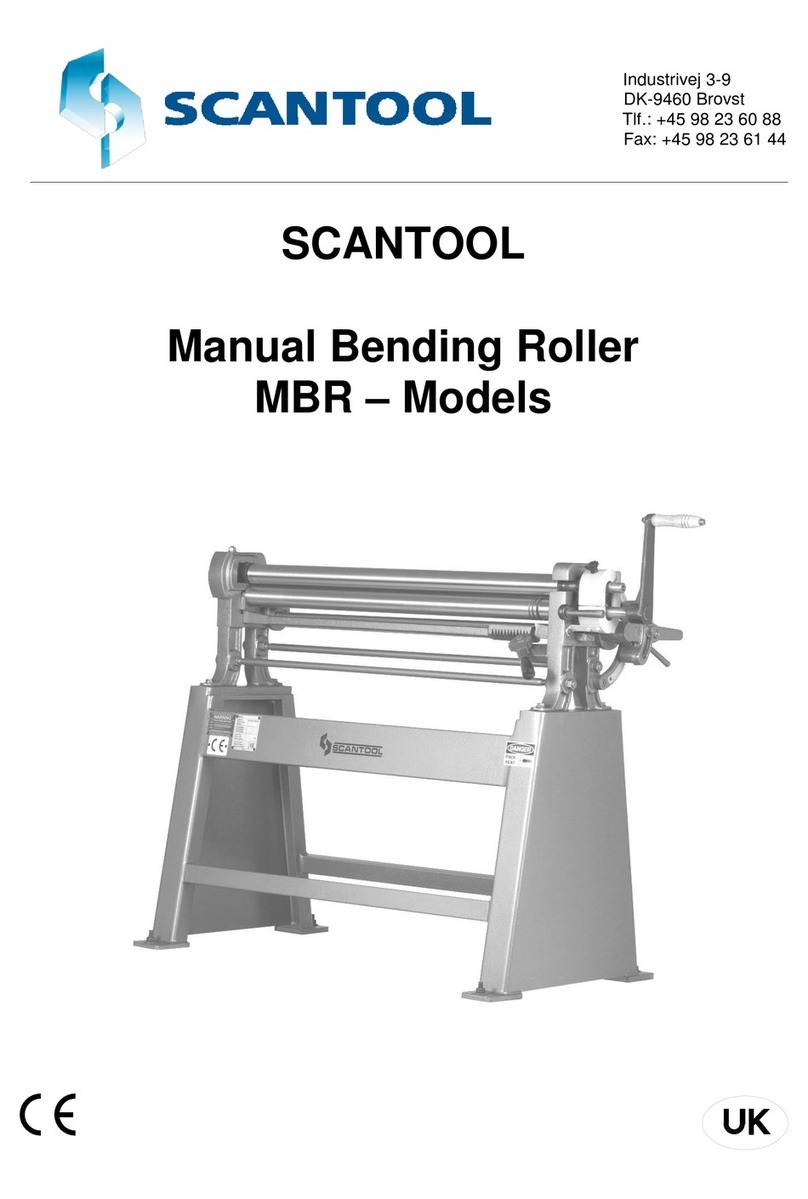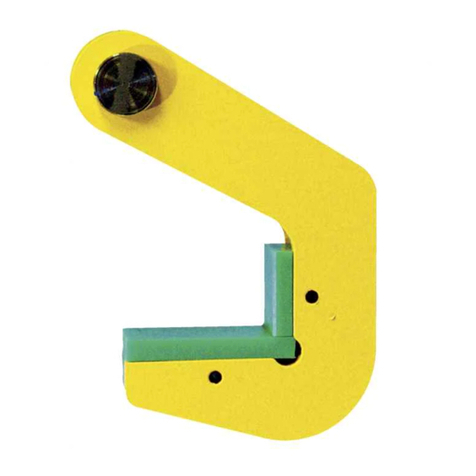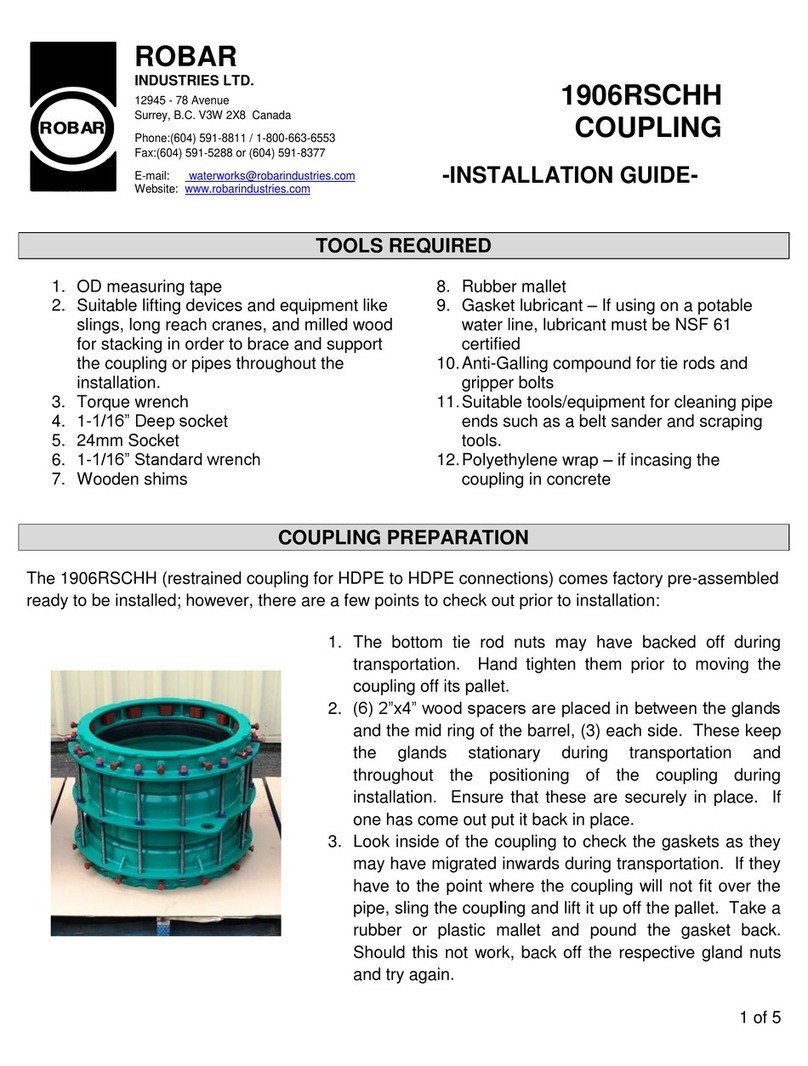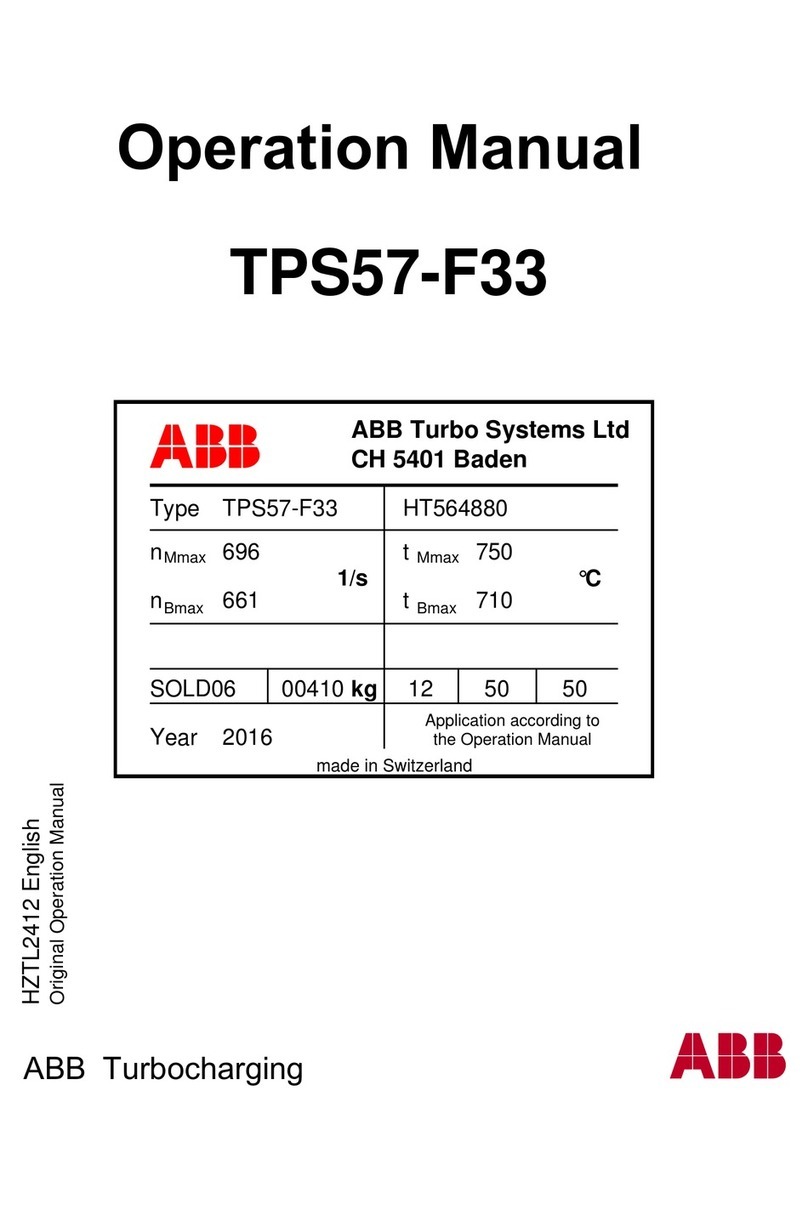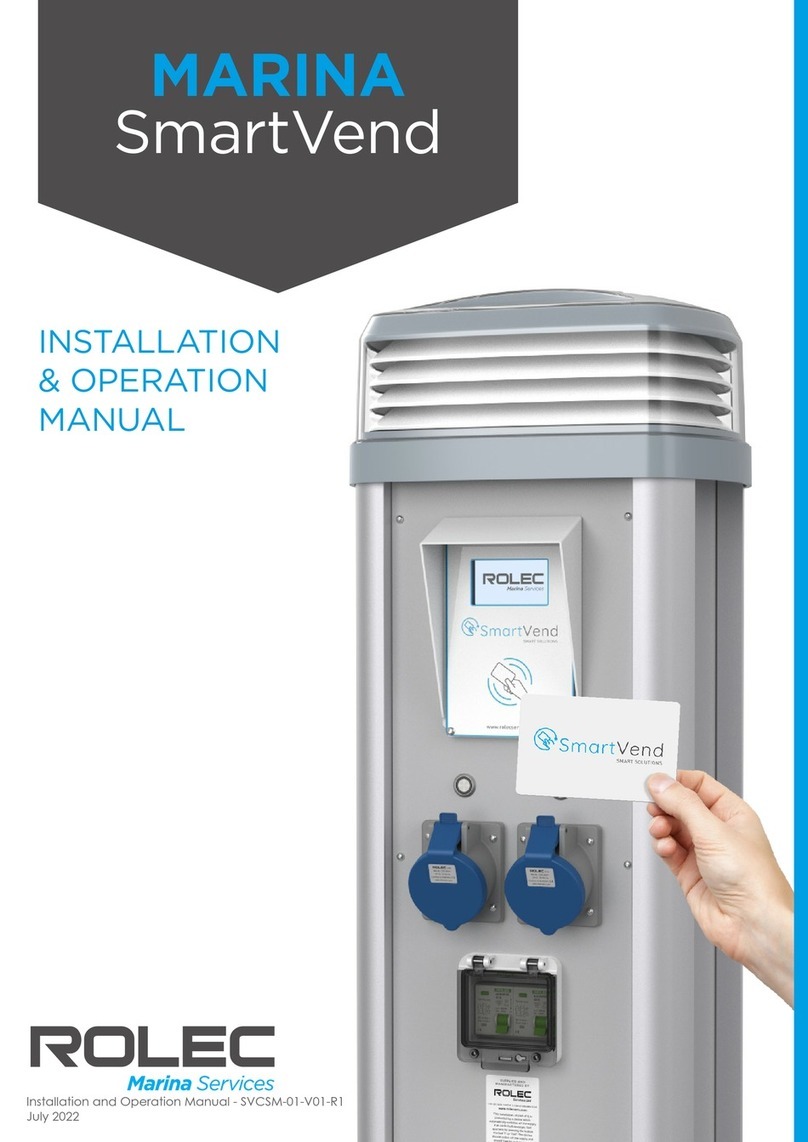Thern Stage Equipment DW1M1-S4 User manual

Owner’s Manual
For
DW1M1-S4 Capstan
SA9895A-0316
Read this Owner’s Manual
thoroughly before operating
the equipment. Keep it with
the equipment at all times.
Replacements are available
from TSE, PO Box 347,
Winona, MN 55987,
507-454-2996.
www.thernstage.com
IMPORTANT: Please record
product information on
page 2. This information is
required when calling the
factory for service.
ORIGINAL TEXT

Owner's Manual for Thern DW1M1-S4 Capstan
page 2
SA9895A-0316
Two-Year Limited Warranty
Thern, Inc. warrants its products against defects in material or workmanship for two years from the date of purchase
by the original using buyer, or if this date cannot be established, the date the product was sold by Thern, Inc. to the
dealer. To make a claim under this warranty, contact the factory for an RGA number. The product must be returned,
prepaid, directly to Thern, Inc., 5712 Industrial Park Road, Winona, Minnesota 55987. The following information
must accompany the product: the RGA number, the date of purchase, the description of the claimed defect, and a
complete explanation of the circumstances involved. If the product is found to be defective, it will be repaired or
replaced free of charge, and Thern, Inc. will reimburse the shipping cost within the contiguous USA.
This warranty does not cover any damage due to accident, misuse, abuse, or negligence. Any alteration, repair or
modication of the product outside the Thern, Inc. factory shall void this warranty. This warranty does not cover any
costs for removal of our product, downtime, or any other incidental or consequential costs or damages resulting from
the claimed defects. This warranty does not cover brake discs, wire rope or other wear components, as their life is
subject to use conditions which vary between applications.
FACTORY AUTHORIZED REPAIR OR REPLACEMENT AS PROVIDED UNDER THIS WARRANTY IS THE
EXCLUSIVE REMEDY TO THE CONSUMER. THERN, INC. SHALL NOT BE LIABLE FOR ANY INCIDENTAL
OR CONSEQUENTIAL DAMAGES FOR BREACH OF ANY EXPRESS OR IMPLIED WARRANTY ON THIS
PRODUCT. EXCEPT TO THE EXTENT PROHIBITED BY APPLICABLE LAW, ANY IMPLIED WARRANTY
OF MERCHANTABILITY OR FITNESS FOR A PARTICULAR PURPOSE ON THIS PRODUCT IS LIMITED IN
DURATION TO THE DURATION OF THIS WARRANTY.
Some states do not allow the exclusion or limitation of incidental or consequential damages, or allow limitations on
how long an implied warranty lasts, so the above limitation or exclusion may not apply to you. This warranty gives
you specic legal rights, and you may also have other rights which vary from state to state.
Note: Thern, Inc. reserves the right to change the design or discontinue the production of any product without
prior notice.
About This Manual
The Occupational Safety and Health Act of 1970 states that it is the employer’s
responsibility to provide a workplace free of hazard. To this end, all equipment
should be installed, operated, and maintained in compliance with applicable
trade, industrial, federal, state, and local regulations. It is the equipment owner's
responsibility to obtain copies of these regulations and to determine the suitability
of the equipment to its intended use.
This Owner’s Manual, and warning labels attached to the equipment, are to serve
as guidelines for hazard-free installation, operation, and maintenance. They
should not be understood to prepare you for every possible situation.
The information contained in this manual is applicable only to the Thern DW1M1-S4
Capstan. Do not use this manual as a source of information for any other equipment.
The following symbols are used for emphasis throughout this manual:
Failure to follow ‘WARNING!’ instructions may result in equipment damage,
property damage, and/or serious personal injury.
Failure to follow ‘CAUTION!’ instructions may result in equipment damage,
property damage, and/or minor personal injury.
Important!
Failure to follow ‘important!’ instructions may result in poor performance of
the equipment.
Please record the following:
Date Purchased:
Model No.:
Serial No.:
This information is required when
calling the factory for service.

Owner's Manual for Thern DW1M1-S4 Capstan page 3
SA9895A-0316
Suggestions for Safe Operation
DO the following:
Read and comply with the guidelines set forth in this Owner’s Manual.
Keep this manual, and all labels attached to the unit, readable and with the
equipment at all times. Contact Thern, Inc. for replacements.
Check gearbox for lubrication or leakage before use.
Install the synthetic ber rope securely to the unit drum. Keep at least 3
wraps of synthetic ber rope wound on the drum at all times, to serve as
anchor wraps. With less than 3 wraps on the drum the synthetic ber rope
could come loose, causing the load to escape.
Keep hands away from the pinch points between the drum and the synthetic
ber rope, and other moving parts of the equipment.
The unit is equipped with a load brake as it is used to lift loads. Contact
Thern Inc. for more information.
Keep all unnecessary personnel away from unit while in operation. Keep out
of the path of the load.
Disconnect electric power before servicing the equipment.
DO NOT do the following:
Do not lift people or things over people.
Do not exceed the load rating of the unit or any other component in the
system. To do so could result in failure of the equipment.
Do not use more than one unit to move a load unless each unit was
designed for a multiple unit system.
Do not use damaged or malfunctioning equipment. To do so could result in
failure of the equipment.
Do not modify the equipment in any way. To do so could cause equipment failure.
Do not wrap the synthetic ber rope around the load. This damages the
synthetic ber rope and could cause the load to escape. Use approved rigging
connectors to secure the synthetic ber rope to the load.
Do not operate the unit with drive guards or gear covers removed or
improperly installed.
Do not divert your attention from the operation. Stay alert to the possibility of
accidents, and try to prevent them from happening.
Do not jerk or swing the load. Avoid shock loads by starting and stopping the
load smoothly. Shock loads overload the equipment and may cause damage.
Do not rely on unit to hold unattended loads. Do not leave a suspended load
unattended unless specic precautions have been taken to secure the load and
keep people away from the unit and out from under the load.
Do not adjust the brake with the unit holding a load. Accidental release of the
brake could allow the load to escape.

Owner's Manual for Thern DW1M1-S4 Capstan
page 4
SA9895A-0316
1.1 Installing the Unit
Do not install the unit in an area dened as hazardous by the National
Electric Code, unless installation in such an area has been thoroughly
approved.
Do not install the unit near corrosive chemicals, ammable materials,
explosives, or other elements that may damage the unit or injure the operator.
Adequately protect the unit and the operator from such elements.
Position the unit so the operator can stand clear of the load, and out of the
path of a broken synthetic ber rope that could snap back and cause injury.
Attach the unit to a rigid and level foundation that will support the unit and
its load under all load conditions, including shock loading.
1.1.1 CONSULT APPLICABLE CODES AND REGULATIONS for specic rules
on installing the equipment.
1.1.2 LOCATE THE UNIT in an area clear of trafc and other obstacles. Make
sure the unit is accessible for maintenance and operation.
1.1.3 LOCATE THE UNIT in an area with adequate temperatures. Check the motor
and reducer manufacturer’s information for ambient temperature ratings.
1.1.4 POSITION THE UNIT to insure proper lubrication.
1.1.5 INSTALL THE UNIT on a horizontal surface. The unit is designed and
assembled for horizontal base mounting.
1.1.6 MAINTAIN A FLEET ANGLE between 1/2 and 1-1/2 degrees. The proper
eet angle minimizes synthetic ber rope damage by helping the synthetic
ber rope wind uniformly onto the drum.
1.1.7 MAKE SURE THE REACTION BAR and lock rail are secured to a solid
foundation able to support the reaction bar, lock rail and the load under all
conditions with design factors based on accepted engineering practices.
See Section 2.4
TO COMPLY WITH LOCAL CODES, CONTACT A QUALIFIED
PROFESSIONAL TO OBTAIN PROPER STRUCTURE OR FOUNDATION
SPECIFICATIONS FOR THE MOUNTING OF THERN PRODUCTS.
Important!
• Inspect the unit immediately
following installation according
to the Instructions for Periodic
Inspection. This will give you a
record of the condition of the unit
with which to compare future
inspections.
• A qualied professional should
inspect or design the reaction
bar to insure that it will provide
adequate support.
• Locate the unit so it will be visible
during the entire operation.
• Do not attempt to lift or position
unit by using frame brace. This
may cause damage to unit.
• Do not attempt to lift or position
unit by using lifting hole on
reducer. This hole is designed to
lift reducer only.

Owner's Manual for Thern DW1M1-S4 Capstan page 5
SA9895A-0316
1.2 Installing the Breather Plug
Install the breather plug to vent heat and pressure. Failure to do so could
result in pressure buildup which could damage the reducer.
For shipment, the reducer is lled with lubricant and sealed to prevent
lubrication loss.
1.2.1 REMOVE THE O-RING(S) from the breather plug hole. See Figure 1.
1.2.2 CHECK THE LUBRICANT LEVEL in the reducer to make sure no lubricant
was lost during shipment. Refer to the reducer manufacturer’s instructions.
Figure 1 – O-Ring
Important!
• Save the O-Ring for use when
the unit is removed for storage or
transport.

Owner's Manual for Thern DW1M1-S4 Capstan
page 6
SA9895A-0316
1.3 Connecting Electric Power
Install proper branch circuits, disconnect devices, protection, and grounding
as required by article 430 of the National Electric Code.
All electrical work must be performed by a licensed electrician. Failure to do
so could result in electric shock or poor unit operation.
1.3.1 CONSULT APPLICABLE CODES AND REGULATIONS for specic rules
on electrical installation.
1.3.2 INSTALL A FUSE or circuit breaker in the power supply circuit, as required
by the National Electric Code.
1.3.3 INSTALL A DISCONNECT DEVICE in the power supply circuit, as
required by the National Electric Code. This should be a switch you can lock
in the OFF position to prevent unauthorized use of the unit.
1.3.4 CONNECT ELECTRIC POWER SUPPLY, with ground wire, to the electric
starter control box. Check the component manufacturer’s information for a
wiring diagram.
1.3.5 CONNECT OTHER ELECTRIC EQUIPMENT to the proper terminals in
the electric control box.
1.3.6 CHECK THE CURRENT at the motor and make sure it agrees with the
current rating marked on the unit nameplate. If current rating is incorrect,
have the circuit inspected by a licensed electrician.
1.3.7 TEST ELECTRICAL CONNECTIONS by operating the unit.
a ROTATION OF THE DRUM must agree with the labels on the control
device, either UP and DOWN, or FORWARD and REVERSE. If reversed,
swap 2 of 3 power legs.
b CHECK THE LOAD BRAKE, make sure it releases when the motor is ON,
and engages when the motor is OFF. Make sure the fast brake function
operates correctly on brakemotors that include this feature.
CONTACT THE FACTORY OR A QUALIFIED PROFESSIONAL FOR HELP.
Important!
• Use electrical equipment with the
correct rating and Underwriter’s
Laboratory (UL) approved.
• Always disconnect electric current
when the unit is not in use.

Owner's Manual for Thern DW1M1-S4 Capstan page 7
SA9895A-0316
1.4 Installing the Synthetic Fiber Rope
Wrap the synthetic ber rope securely to the unit drum. A poorly secured
synthetic ber rope could slip and allow the load to escape. See Figure 2.
1.4.1 DETERMINE WHICH DIRECTION the drum must rotate to wind and
unwind synthetic ber rope.
1.4.2 PURCHASE THE PROPER SYNTHETIC FIBER ROPE for your
application. Keep the following in mind when selecting a synthetic ber
rope. Contact a reputable synthetic ber rope supplier for help.
a BREAKING STRENGTH of new synthetic ber rope should be at least 8
times greater than the hoist rating. These are minimum values and will vary
with the type of load and how you are moving it.
b SYNTHETIC FIBER ROPE LAY must agree with the winding direction of
the drum to help insure proper winding.
c WE RECOMMEND 3/4 inch three braid synthetic ber rope or kernmantle
synthetic ber rope.
1.4.3 PASS THE SYNTHETIC FIBER ROPE under the sheave between the
sheave plates.
1.4.4 WIND THREE FULL WRAPS of synthetic ber rope onto the drum by
operating the unit while holding the synthetic ber rope taut. These wraps
serve as anchor wraps and must remain on the drum at all times.
1.4.5 SECURE THE SYNTHETIC FIBER ROPE to the rope cleat to help secure
the load or when not in use.
Figure 2 – Installing the Synthetic Fiber Rope
rope cleat drum sheave
TOP VIEW
Important!
• Use synthetic ber rope and other
rigging equipment rated for the
size of the largest load you will be
moving.
• Do not drag the synthetic ber
rope through dirt or debris that
could cause damage, or poor
operation.
•
Always wear protective clothing
when handling synthetic ber rope.
Important!
• Use a sheave or roller guide to
direct the synthetic ber rope to
the drum whenever possible.
• Install sheaves, tracks and other
equipment so they will remain
xed under all load conditions.
Follow the recommendations of
the equipment manufacturer.
• Use sheaves of proper diameter
to minimize wear on the
synthetic ber rope. Follow the
recommendations of the sheave
manufacturer.

Owner's Manual for Thern DW1M1-S4 Capstan
page 8
SA9895A-0316
2.1 General Theory of Operation
2.1.1 THE PULL REQUIRED to move the load must not exceed the load rating of
the unit. Consider the total force required to move the load, not the weight of
the load.
2.1.2 THIS EQUIPMENT CAN develop forces that will exceed the load rating.
It is the responsibility of the equipment user to limit the size of the load.
Inspect the equipment regularly for damage according to the instructions
contained in this manual and in the component manufacturer’s information.
2.1.3 THIS HOIST CONTAINS A LOAD BRAKE IN ADDITION TO
HELICAL-WORM GEARING TO HOLD THE LOAD IN PLACE.
2.1.4 PERFORMANCE RATINGS of the equipment are affected by the amount
of synthetic ber rope wound on the drum, the way in which it is wound, the
way the unit is used, and tension on the dead end of the rope.
a LOAD RATING represents the maximum pull that can be placed on new
equipment.
2.1.5 DUTY RATINGS refer to the type of use the equipment is subject to.
Consider the following when determining duty rating.
a ENVIRONMENT: harsh environments include hot, cold, dirty, wet,
corrosive, or explosive surroundings. Protect the equipment from harsh
environments when possible.
b MAINTENANCE: poor maintenance, meaning poor cleaning, lubrication,
or inspection, leads to poor operation and possible damage of the equipment.
Minimize poor maintenance by carefully following the instructions
contained in this manual.
c LOADING: severe loading includes shock loading and moving loads that
exceed the load rating of the equipment. Avoid shock loads, and do not
exceed the load rating of the equipment.
d FREQUENCY OF OPERATION: frequent start and stop functions increase
wear and shorten the life span of the gear train and load brake components.
Lengthy operations cause lubrication to become hot, which also decreases
the life span of the gear train. Increase maintenance of the equipment if
used in frequent operations.
CONTACT THE FACTORY FOR MORE INFORMATION.
Important!
• Limit nonuniform winding by
keeping tension on the synthetic
ber rope.
• To help insure rated performance,
make sure voltage at the motor is
equal to the motor’s voltage rating.
• It is your responsibility to detect
and account for different factors
affecting the condition and
performance of the equipment.

Owner's Manual for Thern DW1M1-S4 Capstan page 9
SA9895A-0316
2.2 Breaking-In the Unit
2.2.1 BREAK-IN OCCURS during the rst few hours of normal operation. During
break-in, mating surfaces become polished, and clearances increase. This is
desired for efcient operation of bearings and gears.
2.2.2 INSPECT THE UNIT following break-in according to the Instructions for
Periodic Inspection. See section 3.3 - Inspecting the Equipment.
2.3 Preparing for Operation
2.3.1 CONSIDER THE OPERATION. Do not begin until you are sure you can
perform the entire operation without hazard.
2.3.2 INSPECT ALL COMPONENTS of the system.
a INSPECT THE UNIT and other equipment according to the Instructions for
Frequent Inspection.
b OPERATORS must be in good health, alert, thoroughly trained in operating
the equipment, and properly clothed (hard hat, safety shoes and safety
glasses, no loose clothing).
c THE LOAD must be clear of other objects and free to move. Make sure the
load will not tip, spin, roll away, or in any way move uncontrollably.
2.3.3 KNOW YOUR LOAD and make sure you do not exceed the load rating of
the unit or any other equipment in the system.
2.4 Attaching the Load
Do not wrap the synthetic ber rope around the arbor. This damages the
synthetic ber rope and could cause the load to escape. Use an approved
lifting device.
2.4.1 CLEAR OBJECTS from the path of the load so you can move it freely and
observe it at all times during the operation.
2.4.2 ROLL CAPSTAN into space adjacent to the oor block of the desired
lineset until the reaction bar anchor is fully engaged to the reaction bar.
See Figure 3.
2.4.3 ATTACH THE FIBER ROPE TO THE LOAD using a rated lifting shackle,
or other approved lifting device. Follow the recommendations of the shackle
manufacturer.
2.4.4 DO NOT ATTEMPT to move an arbor that is not directly above the capstan
lead sheave. Reposition the capstan to achieve the least amount of eet angle
between the lead sheave and the arbor.
Important!
• When determining whether the
load will exceed the load rating,
consider the total force required
to move the load.

Owner's Manual for Thern DW1M1-S4 Capstan
page 10
SA9895A-0316
2.5 Moving the Load
Ensure reaction bar anchor is properly engaged to the reaction bar. See
Figure 3.
2.5.1 MOVE THE LOAD slowly and smoothly, only a small distance at rst.
Make sure the load is balanced and securely attached before continuing.
2.5.2 USE THE FOOT PEDAL CONTROL to operate the unit. The foot pedal
control should be a momentary contact type, so the unit will stop when the
operator releases the control.
2.5.3 OBSERVE THE SYNTHETIC FIBER ROPE as it winds onto the
drum. Keep tension on dead end of rope. If it becomes loose, uneven, or
overlapped, stop the operation and rewind the synthetic ber rope before
continuing. Continued operation with overlapped or uneven synthetic
ber rope can damage the synthetic ber rope and shorten its life.
A rope cleat can be used to temporarily hold dead end of rope. DO NOT
LEAVE LOAD UNATTENDED.
2.5.4 OBSERVE THE REDUCER during operation for signs of overheating.
Frequent overheating may be a sign of damage, or may indicate the
need for a larger power unit.
a WATCH FOR SMOKE, the smell of burnt lubricant, and other signs
of overheating. Use a thermocouple or other device to monitor reducer
temperature.
b STOP THE OPERATION if the reducer overheats, and allow the unit to
cool. Continued operation may cause damage.
Important!
• Obey a stop signal from anyone.
• Maintain tension on the synthetic
ber rope to keep it tightly and
evenly wound on the drum.
• If the unit and load are not visible
during the entire operation, get
help from another person.
• Appoint a supervisor if more
than one person is involved in
the operation. This will reduce
confusion and increase safety.
Figure 3 – Reaction Bar
capstan
hoist
capstan reaction
bar anchor reaction bar
lock rail

Owner's Manual for Thern DW1M1-S4 Capstan page 11
SA9895A-0316
3.1 Cleaning the Unit
Clean the unit to remove dirt and help prevent rust and corrosion.
3.1.1 CLEAN THE UNIT every six months or whenever it is dirty.
a WIPE ALL EQUIPMENT to remove dirt and grease.
b LEAVE A LIGHT FILM of oil on all surfaces to protect them against rust
and corrosion.
c WIPE OFF excessive amounts of oil to avoid the accumulation of dirt.
3.1.2 REMOVE ALL UNNECESSARY OBJECTS from the area around the unit.
Important!
Increase the frequency of
maintenance procedures if the
unit is:
• Operated for long periods.
• Used to pull heavy loads.
• Operated in wet, dirty, hot, or
cold surroundings.

Owner's Manual for Thern DW1M1-S4 Capstan
page 12
SA9895A-0316
3.2 Lubricating the Unit
Make sure the breather plug is clean and open to vent heat and pressure. Poor
ventilation may cause overheating and result in damage to oil seals and other
equipment.
Fill the speed reducer to the proper level without overlling. Too much or too
little lubricant will cause overheating and result in damage to seals, bearings,
and gears.
Lubricate the unit properly to help protect it from wear and rust. Read the
following instructions carefully.
3.2.1 MOTOR BEARINGS are typically lubricated for life by the manufacturer.
Some motors require periodic lubrication. Refer to the motor manufacturer’s
information for specic instructions.
3.2.2 LUBRICATE THE REDUCER according to the manufacturer’s instructions.
a CHECK OIL LEVEL before every operation and every 10 hours during
operation. Remove the level plug and make sure oil is even with the plug
hole.
b FILL THE REDUCER according to the manufacturer's instructions. Fill the
reducer until oil reaches the level plug. Do not mix different lubricants.
c CHANGE REDUCER LUBRICANT at least every 2 years, or whenever it is
dirty or contaminated.
Important!
• Do not leave plug holes in the
reducer open. Open plug holes
will allow dirt and moisture to
contaminate the lubrication.
• Make sure lubricant has a
temperature rating appropriate for
the ambient temperatures of the
operation.
• Replace the motor bearings if the
motor is disassembled for any
reason.

Owner's Manual for Thern DW1M1-S4 Capstan page 13
SA9895A-0316
3.3 Inspecting the Equipment
Do not use damaged or malfunctioning equipment. Place an “OUT OF ORDER”
sign on the unit. Do not use the unit until the sign is removed by a qualied
maintenance person who has completely corrected the problem.
Inspect the unit to detect signs of damage or poor operation before they
become hazardous. See Table 1 - Inspection Checklist.
3.3.1 CONSULT APPLICABLE CODES AND REGULATIONS for specic rules
on inspecting the unit and other equipment.
3.3.2 CHECK COMPONENT MANUFACTURER’S INSTRUCTIONS for
inspecting the motor, brake, reducer, bearings, synthetic ber rope, and other
equipment.
3.3.3 Instructions for Frequent Inspection
a VISUALLY INSPECT the entire unit and all other equipment involved in
the operation.
• Check all equipment for cracks, dents, bending, rust, wear, corrosion and
other damage.
• Check the reducer for signs of leakage.
• Make sure the entire unit is properly lubricated.
• Make sure the breather plug is clean, open, and installed correctly.
• Make sure mounting fasteners are tightened securely.
• Make sure the foundation is in good condition, and capable of supporting
the reaction bar and lock rail and its load under all load conditions.
• Check electrical wiring and connections for wear, corrosion, cuts, and
other damage.
b TEST UNIT PERFORMANCE by operating the unit with a load not
exceeding the load rating.
• Listen for unusual noises, and look for signs of damage as you operate the
unit.
• Make sure the synthetic ber rope winds evenly and tightly onto the
drum. If it is loose or uneven, apply more tension to the dead end.
• Make sure the load moves smoothly, without hesitation or strain.
• Make sure the unit responds to the foot pedal control. It must rotate as shown
on the control labels, and it must turn off when you release the control.
• Check the brake. Raise the load, then lower it and stop it a few feet off
the ground. If the load continues to coast or creep under normal operating
conditions, the brake needs adjustment. Refer to brake manufacturer’s
instructions.
Completely correct all problems before continuing. Use the Troubleshooting
Chart to help determine the cause of certain problems. See Table 2.
Important!
• Start an inspection program as
soon as you put the unit into use.
• Appoint a qualied person to
be responsible for regularly
inspecting the equipment.
• Keep written records of
inspection. This allows
comparison with comments from
previous inspections so you
can see changes in condition or
performance.
Perform frequent inspections:
• Monthly.
• Whenever you notice signs of
damage or poor operation.

Owner's Manual for Thern DW1M1-S4 Capstan
page 14
SA9895A-0316
3.3.4 Instructions for Periodic Inspection
a VISUALLY INSPECT the unit and all other equipment.
• Disassembly may be required in order to properly inspect individual
components. Contact factory for assembly/disassembly instructions.
Disassembly of the gearbox before contacting Thern, Inc. voids all
warranties.
• Check the nish for wear, aking, or other damage.
• Check all equipment for cracks, dents, bending, rust, wear, corrosion and
other damage. If the equipment was overloaded, or if you notice cracks
and other signs of overloading and damage, promptly remove equipment
from use and have it repaired or replaced. DO NOT CONTINUE TO USE
DAMAGED OR OVERLOADED EQUIPMENT OR SYNTHETIC
FIBER ROPE.
• Check all fasteners for stripped threads, wear, bends, and other damage.
• Check the gearbox for signs of leakage. Contact the factory if there are
any signs of lubricant leaking from the gearbox.
• Make sure the breather plug is clean, open and installed correctly.
• Make sure gear reducer is properly lubricated.
• Make sure all labels and plates are readable, rmly attached, free of
damage and clean. Replacements are available from the factory.
b DRAIN A SMALL AMOUNT OF LUBRICANT from the reducer into a
clean container.
• Check the lubricant for dirt, metal particles, water, and other signs of
contamination. Completely drain the reducer if lubricant is contaminated.
c
INSPECT ROPE
. Refer to rope manufacturer's guidelines for inspection.
d MOVE THE DRUM with your hands.
• Check for excessive movement indicating worn or loose gears or
bearings. Excessive movement is caused by overloading or overheating,
and is a sign that your application may require a larger power unit.
• Disassemble the unit if necessary. Inspect keys, bearings, seals,
and shafts for wear, distortion, and other damage.
e INSPECT FOUNDATION AND RIGGING.
• Check mounting fasteners for stripped threads, wear, and other damage.
• Check the foundation for cracks, corrosion, and other damage.
Perform periodic inspections:
• Every 12 months.
• Whenever you return the unit to
service from storage.
• Whenever you notice damage
or poor operation in a frequent
inspection.
• Whenever you have, or think you
may have, overloaded or shock
loaded the unit.
Frequent Rope Inspection:
•Use Cordage Institute Interna-
tional Guidelines CI2001-04 as
a guideline for rope inspection,
replacement and maintenance.

Owner's Manual for Thern DW1M1-S4 Capstan page 15
SA9895A-0316
f TEST UNIT PERFORMANCE by operating the unit with a test load equal
to the load rating.
• Listen for unusual noises, and look for signs of damage as you operate the
unit.
• Observe the rotating drum, look for signs of loose or misaligned bearings.
• Make sure the unit responds to the control device. It must rotate as shown
on the control labels, and it must turn off when you release the control.
• Make sure the load moves smoothly without hesitation or strain.
• Check the brake. Raise the load, then lower it and stop it a few feet off
the ground. If the load continues to coast or creep under normal operating
conditions, the brake needs adjustment. Refer to brake manufacturer’s
instructions.
g DISCONNECT ELECTRIC POWER and inspect electrical equipment.
• Check electrical wires for worn insulation, cuts, corroded connections,
and other damage.
• Make sure the electrical control box is securely installed. Look inside
the control box for signs of moisture, corrosion, burn marks, cracks, and
other damage.
h CONNECT ELECTRIC POWER.
• Check voltage of electrical supply with a UL approved voltmeter. If
voltage is low, have a licensed electrician inspect the circuit.
• Check power supply at the motor and make sure it agrees with the motor
rating. Do not operate the unit until proper power is supplied to the motor.
Completely correct all problems before continuing. Use the troubleshooting
chart to help determine the cause of certain problems. See Table 2.

Owner's Manual for Thern DW1M1-S4 Capstan
page 16
SA9895A-0316
Table 1 – Inspection Checklist
damages problems
general nishweathered,aking,otherwisedamaged unitjerksorhesitatesduringoperation
partscracked,bent,rusted,worn,otherwisedamaged unusualnoises,othersignsofmalfunction
fasteners strippedthreads,bent,worn,otherwisedamaged loose,nottightenedtopropertorque
reducer gears,bearings,orshaftsloose,worn,otherwisedamaged notproperlylubricated
lubricantleakage lubricantcontaminated
end connections corroded,rusted,worn,otherwisedamaged notsecurelyattached
shackle twisted,bent,worn,otherwisedamaged shackledoesnotholdload
drum worn,distorted,otherwisedamaged excessivemovementorbacklash
motor motorcorroded,burntout,otherwisedamaged motorissluggish,oroperatespoorly
brake brakeworn,corroded,otherwisedamaged brakedoesnotoperateproperly
control device electriccomponentscorroded,burnt,otherwisedamaged failstocontrolunitproperly
electric circuit electricwiresworn,cut,corroded,otherwisedamaged wiresunprotected,obstructingtrafc
connectionsloose,corroded,otherwisedamaged voltageatmotor=
labels and plates dirty,illegible,otherwisedamaged looselyattachedormissing
comments
authorized signature date
checked boxes indicate damage or problem in need of repair

Owner's Manual for Thern DW1M1-S4 Capstan page 17
SA9895A-0316
Table 2 – Troubleshooting Chart
Contact the factory for assembly/disassembly instructions. Disassembly of the gearbox before contacting Thern,
Inc. voids all warranties.
problem cause correction
motor won’t run •circuitbreakertrippedorfuseblown .........resetcircuitbreakerorreplacefuse
•electricalconnectionslooseordamaged .....inspect,repairandtightenasnecessary
•electricpowersupplyfailure ...............contactpowercompany
•motorburntoutordamaged ...............repairorreplaceasnecessary
motor runs, drum doesn’t turn •looseorbrokengearkeys.................inspectandreplaceasnecessary
•loose,strippedorbrokengears ............inspectandreplaceasnecessary
motor tries to turn but can’t •unitoverheated .........................allowtocool
•loadtooheavy..........................lightenload
•voltageatmotortoolow ..................inspectsupplycircuitandrewireasneeded
•electricbrakenotoperatingproperly.........inspectandrepairasnecessary
•gearsorbearingsbrokenorlocked .........inspectandreplaceasnecessary
brake does not operate properly •brakereleaseleverinreleaseposition .......movetolockposition
•voltagetobrakeincorrect .................checkvoltageatcontrolbox,repairasneeded
•brakeadjustedincorrectly .................adjustbrake
•brakediscsorsolenoidwornordamaged ....inspectandreplaceasnecessary
•brakecomponentsseizedupordamaged ....inspectandrepairasnecessary
lubricant leakage •wornbearings ..........................inspectandreplaceasnecessary
•damagedoilsealsorgaskets ..............inspectandreplaceasnecessary
•crackedordamagedreducer ..............inspectandrepairasnecessary
excessive end play on drive shaft •looseordamagedkeysorkeyways .........inspectandreplaceasnecessary
•excessivelyworngears...................inspectandrepairasnecessary
excessively worn gears or bearings •loadtooheavy..........................lightenload
•poorlubricationofreducerorbearings .......inspectandlubricateasnecessary
overheating •operatedtoolongwithoutrest..............allowtocool
•loadtooheavy..........................lightenload
•poorlubrication .........................inspectandlubricateasnecessary
•breatherplugcloggedordamaged ..........cleanorreplaceventplugasneeded
•bearingseizedup .......................inspectandreplaceasnecessary
unusual noises
highpitchedsqueak •poorlubrication .........................inspectandlubricateasnecessary
grindingnoise •contaminatedlubrication ..................drain,cleanandlubricatetheunit
•brokengearsorbearings .................inspectandreplaceasnecessary
whiningmotor •loadtooheavy..........................lightenload
•motoroverheated .......................allowtocool
•motorbearingsburntout..................replacemotororbearings
rattlingnoise •loosefastenersorsetscrews ..............tightenallfastenersandscrews
•wornorloosedragbrake .................inspectandrepairortightenasnecessary
heavythumpduringoperation •contaminantsinlubricant .................drain,cleanandlubricatetheunit
•loosesetscrewsorkeysingearsorshafts ...inspectandrepairasnecessary
•bearingsdefective.......................inspectandreplaceasnecessary

Owner's Manual for Thern DW1M1-S4 Capstan
page 18
SA9895A-0316
3.4 Repairing the Unit
3.4.1 GET FACTORY AUTHORIZATION for all repairs. Unauthorized repairs
will void the warranty, and may lead to damage or failure of the unit.
3.4.2 REPLACE DAMAGED OR POORLY OPERATING PARTS with Thern
repair parts.
3.4.3 REFINISH AREAS where the paint is worn or aking. A good nish helps
to protect against corrosion and weather damage.
a REMOVE THE FINISH from damaged areas, down to the bare metal.
b CLEAN THE AREA thoroughly.
c REPAINT with a high quality primer and nishing coat.
3.4.4 TO ORDER REPAIR PARTS, contact your local dealer. Include the
following information when ordering:
• model number
• serial number (or code number)
• part number
• date purchased, and from whom
• description of what happened, or what is wrong
• your name and return address
Important!
• It is your responsibility to
determine when to replace parts.
When considering whether to
continue using a part or to replace
it, remember that replacing it
is the best way to avoid further
equipment damage.
• Appoint a qualied person to be
responsible for all repairs to the
equipment.

Owner's Manual for Thern DW1M1-S4 Capstan page 19
SA9895A-0316
4.1 Transporting the Unit
4.1.1 PACK THE UNIT in an upright position for transport, using the original
packaging materials, if possible.
a FASTEN THE UNIT to a wooden base using bolts, to keep it from moving
during transport.
b SEAL THE UNIT in plastic with a desiccant to help protect it from rust,
corrosion, and other damage.
c CONSTRUCT WOODEN SIDES and top to enclose the unit in a solid
protective crate.
d PACK LOOSE PARTS in small boxes or ship separately.
4.1.2 INSPECT THE UNIT according to the Instructions for Periodic Inspection
before installing it in a new location.
4.2 Storing the Unit
4.2.1 FILL THE REDUCER with lubricant, and make sure the breather plug is
clean and properly installed. Add a rust preventative for long term storage.
Follow the reducer manufacturer’s instructions.
4.2.2 SEAL THE UNIT in plastic with a desiccant to help protect it from rust,
corrosion, and other damage.
4.2.3 STORE THE UNIT upright, in a cool clean place away from corrosive
chemicals and moisture.
4.2.4 ROTATE THE DRUM PERIODICALLY to keep bearing and gears surfaces
from becoming lacquered. Release the brake to rotate the drum.
4.2.5 INSPECT THE UNIT according to the Instructions for Periodic Inspection
before installing it for operation.
4.2.6 TEST INSULATION RESISTANCE in the motor to detect moisture
damage. Refer to the motor manufacturer’s instructions.
4.2.7 DRAIN THE REDUCER and ll with proper lubricant prior to operation.
See section 3.2 - Lubricating the Unit.
Important!
• Keep a record of what you ship,
and when you send it.

A division of:
Thern, Incorporated
5712 Industrial Park Road
Winona, MN 55987
PHN 800-553-2204
FAX 507-454-5282
EMAIL: [email protected]
www.thernstage.com
Table of contents
